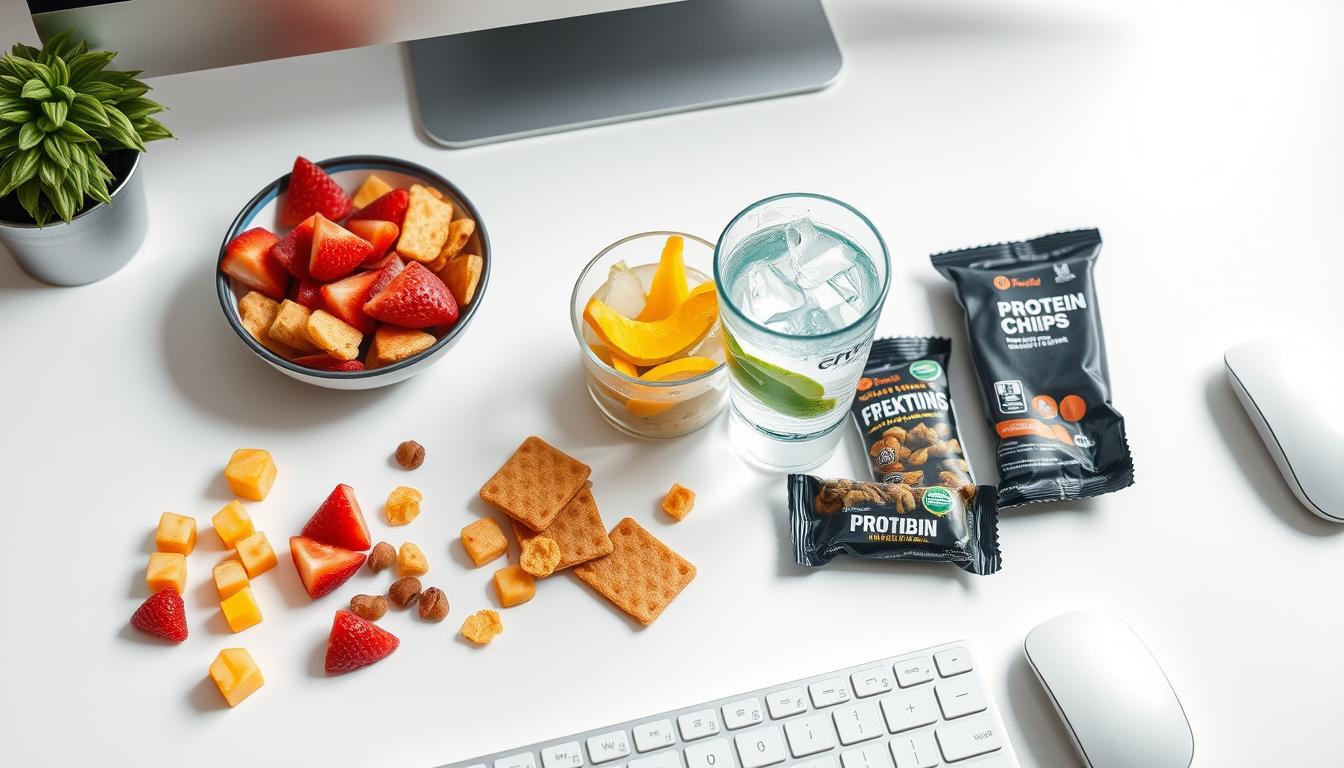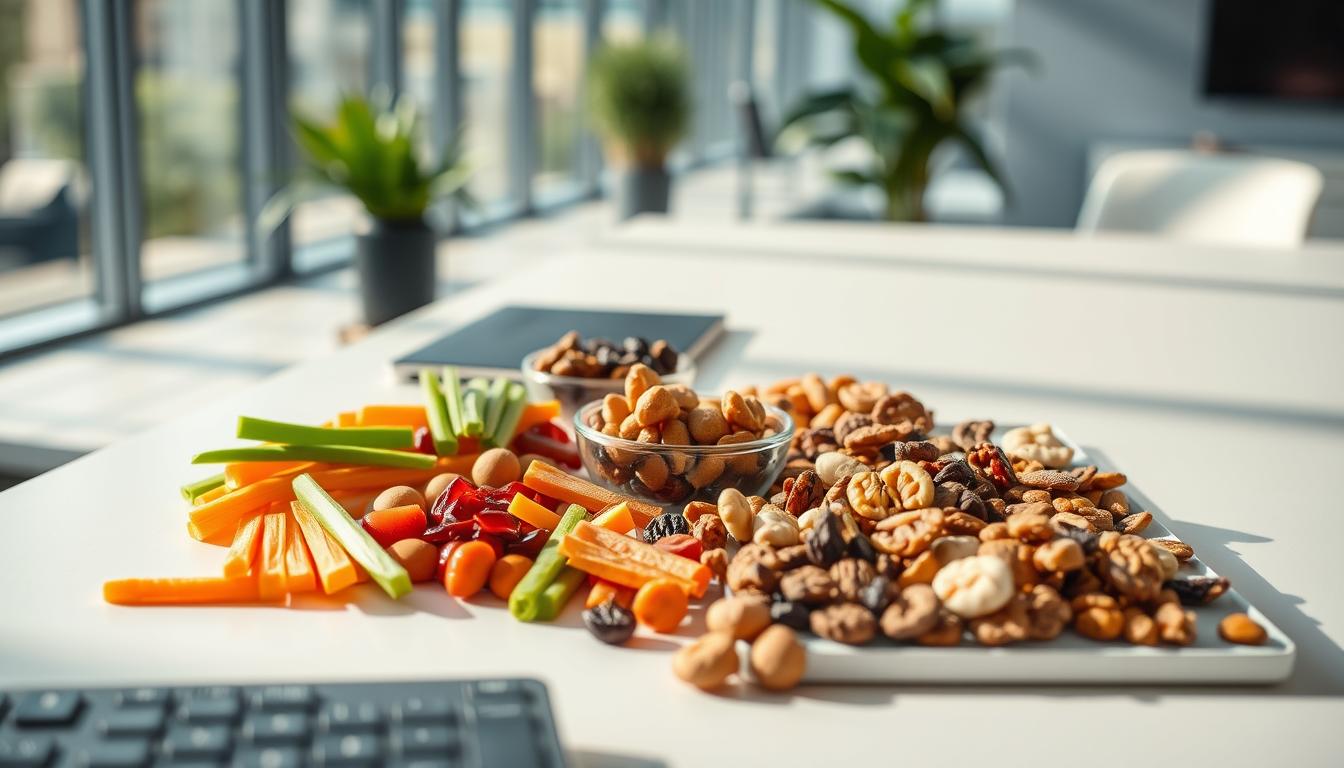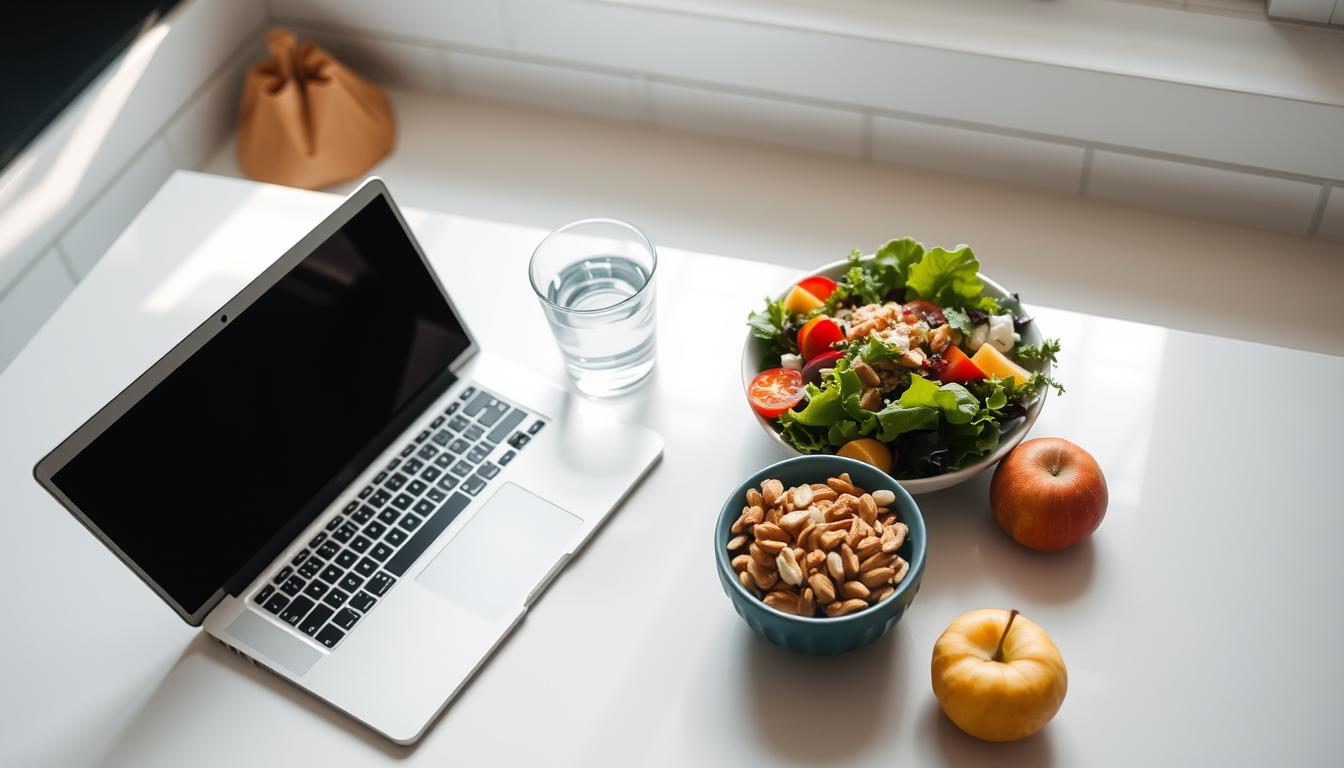Today’s fast work life makes it hard to keep healthy eating habits. But, clean eating can change your work meals greatly. It means choosing fresh, whole foods that boost health and keep messes low at work. Eating these foods improves focus and health, helping you work better without mess.
Simple meal prep and easy clean-eating options can help workers make better food choices. This article is your go-to for clean eating at work tips. We’ll cover everything from preparing meals to picking the right containers, making your workday meals better.
Understanding Clean Eating
Clean eating is all about whole foods like fruits, vegetables, whole grains, lean proteins, and healthy fats. It means eating less added sugars, unhealthy fats, and processed stuff. Choosing foods that are as close to their natural state as possible is key.
Definition of Clean Eating
Clean eating means picking foods that are not heavily processed. Such foods are better for your health and energy. Planning meals with these wholesome ingredients is a big part of clean eating.
Benefits of Clean Eating at Work
Eating clean is especially good for workplace health. It helps you stay focused and energized all day. Eating whole foods over junk snacks keeps your desk and body clean.
Instagram influencers make clean eating look good, inspiring better meal prep for work. Unfortunately, only 10% of Americans eat enough fruits and veggies. Making better food choices reduces the risk of diseases like heart issues and cancer.
Planning Your Work Meals
Busy professionals need efficient meal prep to keep up clean eating habits. Planning meals ahead helps reduce stress and keep healthy eating on track. With simple preparations, nutrient-rich meals are easy to have on busy days.
Meal Prep Ideas for Busy Professionals
Meal prep can greatly help maintain a balanced diet. Here are some ideas to consider:
- Slow cooker lentil curry for a tasty, filling dish.
- Sheet pan chicken fajitas packed with protein and colorful veggies.
- Healthy wraps with fresh vegetables, perfect for quick lunches.
- Curried turkey lettuce wraps for a low-carb, satisfying meal.
- Chickpea salad that’s crunchy and packed with nutrients.
Easy-to-Prepare Clean Eating Recipes
Clean eating recipes make for delicious, nutritious lunches. These ideas are quick and simple:
- Zesty Mexican-inspired salad with colorful veggies and a crunchy topping.
- Tomato & pasta soup, budget-friendly and easy to carry in a flask.
- Falafel wrap with red cabbage, cucumber, gherkin, and spinach for a tasty twist.
- Pasta salad with capers and pesto, easy with pantry items.
- Chicken & tzatziki wraps for a fresh, nutritious lunch.
Pack Wisely
Effective meal packing changes your workplace eating experience. Picking the right containers is key for success in clean eating. Choose containers with tight lids to prevent leaks and spills.
This keeps your space clean and promotes healthy food storage. Use compartments to separate wet and dry ingredients. This stops sogginess and keeps meals appetizing.
Choosing the Right Containers
For meal packing, use containers that work for both hot and cold foods. Keep dressings and sauces separate to avoid soggy salads. Freeze liquids overnight for a cool drink that doesn’t water down your meal.
Use small, divided containers to stay organized and prioritize healthy storage.
Portion Control for Healthy Eating
Portion control is crucial for managing calorie intake. Prep meals the night before to save time and keep food fresh. Choose light, fiber-rich meals that are simple to pack.
Adding vegetables to your lunches makes them tasty. Be creative with leftovers for quick, nutritious meals like burritos. Remember, well-portioned meals lead to a balanced diet, making your workday better.
Grocery Shopping for Clean Eating
Grocery shopping is key for clean eating. Choosing fresh ingredients is very important for a healthy diet. It’s best to pick seasonal fruits and veggies. This boosts meal taste and their health benefits. Planning helps keep a stock of good food. This reduces choosing unhealthy processed food.
Choosing Fresh Ingredients
For clean eating, always go for fresh items. Your choices should include:
- Fresh fruits and vegetables that are in season.
- Canned or frozen produce without extra sugars or salt.
- Whole grains like quinoa, brown rice, and oats for meal variety.
- Meats with one ingredient and sustainable seafood for protein.
- Plain dairy or unsweetened non-dairy options to fit clean eating.
Plan your meals with these fresh items to eat healthily. A weekly menu helps avoid buying things you don’t need. This means all meals are thought out and made.
Reading Labels for Clean Options
Understanding food labels is also crucial. It helps avoid unwanted chemicals, too much sugar, and too much salt. When looking at labels, remember these tips:
- Pick products with few and minimally processed ingredients.
- Choose items without added sugars. Use fruit for sweetness.
- Opt for frozen and canned veggies without added sauces or salt.
Follow these rules for a better clean eating shopping trip. Mixing fresh ingredients with careful label reading leads to healthier meals. This makes preparing clean meals easier throughout the week.
Healthy Snacking to Avoid Messy Eating at Work
Keeping your eating area clean at work can be tough, especially with snacks. Choosing healthy snacks can make this easier. They keep your desk clean and give you the right nutrition.
Here are some snacks that are easy to bring along. They won’t make a mess. Plus, they are good for you.
Portable Snack Options
- Fresh fruits like bananas, apples, and oranges are great for a quick bite. They’re easy to bring along and need no prep.
- Single-serve yogurts are a clean option to beat hunger without any mess.
- Part-skim string cheese sticks are a tidy way to get some protein.
- Low-fat, whole-grain crackers with peanut butter are neat and fill you up.
- Baked potato chips are a less messy, healthier chip option.
- Hummus with celery, baby carrots, or sliced peppers offers a crunchy, nutritious snack without the mess.
- Individually portioned dark chocolate is a neat treat for those sweet cravings.
- Trail mix in small baggies allows for easy portion control and less mess.
- Fruit skewers with honey or yogurt dip are easy to handle and not messy.
- Water is a clean, healthy choice that keeps you hydrated.
Nutritious Self-Made Snack Ideas
Making your own snacks is easy and lets you pick what you want. Here are some snack ideas:
- Mixed nuts or trail mix are full of protein, healthy fats, and fiber. They help keep your energy up.
- Fresh fruit and nut bars are easy to make and take with you. They’re tidy too.
- Homemade protein bars are quick to eat and don’t make a mess.
- Energy bites with oats, nut butter, and honey are tasty and perfect for on-the-go.
- Veggie sticks with dip are a clean and healthy choice for work snacks.
When employers offer various healthy snacks and drinks, it boosts the workplace vibe and employee health. Such options help keep energy steady. This, in turn, boosts productivity and keeps your mind sharp.
How to Stay Organized at Work
Keeping your workspace organized is key to healthier eating choices. A special spot for eating helps you avoid mess and bad food choices. By arranging your work area well, you make a great space for good work and eating habits.
Designating a Clean Eating Space
Setting up a specific spot for eating helps keep your desk clean. This place should be away from old food and smells that come from desk dining. Despite most office workers eating at their desks, having a special area for eating lets people enjoy their food without messing up their work area.
Also, taking time for meals, even briefly, can help you focus and feel more energetic.
Keeping a Tidy Desk for Healthy Eating
It’s vital to keep your desk organized for healthier eating. A neat space helps you stay focused and disciplined. Regularly check and tweak your meal plan to align with your health goals and keep your area neat.
Tools like Bordio help with meal planning and shopping, making prepping easier. A system for clearing and replacing items in your kitchenette or desk ensures only needed things are kept.
Mindful Eating Practices
Embracing mindful eating improves your healthy habits at work. It lets you bond with your food while noting hunger and fullness. Mindful eating makes every meal more fun and purposeful. It aids better digestion and prevents the mess from eating too quickly.
Listening to Hunger and Fullness Cues
Knowing when you’re truly hungry is key to mindful eating. Being in tune with hunger signals helps you choose the right time and amount to eat. To connect with your body, try these:
- Listening closely to your stomach to determine true hunger.
- Chewing each bite thoroughly, aiming for about 30 chews per mouthful to increase freshness and awareness of textures.
- Pausing during meals to assess your fullness, which can prevent overeating and messy spills.
Avoiding Distractions While Eating
To stay focused on your food, eat without distractions. This makes your meals more enjoyable and meaningful. For a better experience, consider:
- Eat without screens such as phones or computers nearby; this limits interruptions and cultivates a peaceful eating environment.
- Engage your senses by savoring the aroma, texture, and flavors of your food, making meals more satisfying.
- Practice gratefulness for your meals, appreciating their origin and the effort involved in preparing them.
Staying Hydrated
Staying hydrated is key for keeping your energy and focus up during the day. Not drinking enough water can make you less productive. It can also make you want unhealthy snacks. About 60% of your body is water, showing how important it is to drink fluids regularly. You should try to drink six to eight cups of fluids every day. Also, up to 25% of the water you need can come from food.
Healthy drinks at work can help keep you refreshed. Adding foods high in water to your diet is good for your health too. For example, strawberries are 91% water, watermelons are 92% water, and lettuce is 96% water. These foods help a lot with staying hydrated. Soups, smoothies, and casseroles can also increase your water intake and give you important nutrients.
Feeling thirsty doesn’t always mean you’re dehydrated. This can happen after eating spicy food. You can check if you’re drinking enough water by looking at your urine color. Light color means you’re well-hydrated, but darker yellow means you need more water. To stay hydrated and eat clean at work, try adding watermelon, spinach, and cucumbers to your meals. These foods help you drink enough water and meet your health goals.
Dealing with Temptations
It’s tough to ignore cravings for processed snacks, especially at work where temptations are everywhere. Using effective strategies can help you manage these cravings. Being prepared and having healthy snacks available can make a big difference.
Strategies to Avoid Processed Snacks
Here are some ways to fight the draw of processed snacks:
- Think about why you’re craving something. Understand your hunger and choose wisely.
- Imagine how good you’ll feel after eating something healthy instead of junk food.
- Have healthy snacks like nuts, fruits, or veggies ready to go.
- Plan and prepare your meals ahead of time for easy, healthy eating.
- Drink plenty of water to tell if you’re really hungry or just thirsty.

Fighting Cravings with Healthy Alternatives
When you feel a craving, it helps to have a plan:
- Don’t eat at your desk to avoid eating without thinking and making a mess.
- Think about what’s making you crave snacks. It could help handle them better.
- Do something active like walking or dancing to distract yourself from cravings.
- Try calming your mind with deep breaths or meditation to lessen cravings.
- Getting enough sleep can help you maintain a healthy relationship with food and fight off cravings.
Conclusion
Eating clean at work boosts your health and how others see you professionally. By learning about clean eating, you can choose better and avoid messy eatings. Studies show that a neat place can make you pick healthier foods. This happens because you’re less likely to grab junk food in tidy spots.
Mindful eating and meal planning are key for a healthier office life. Eating away from your desk not only keeps things clean but also helps you bond with coworkers. Taking this break refreshes you, making you more productive and clear-headed all day.
Having a clean desk encourages better eating habits and lowers health risks in the long run. By sticking to clean eating and keeping things orderly, you’ll do better at your job. Plus, you’ll build healthy habits that last.



